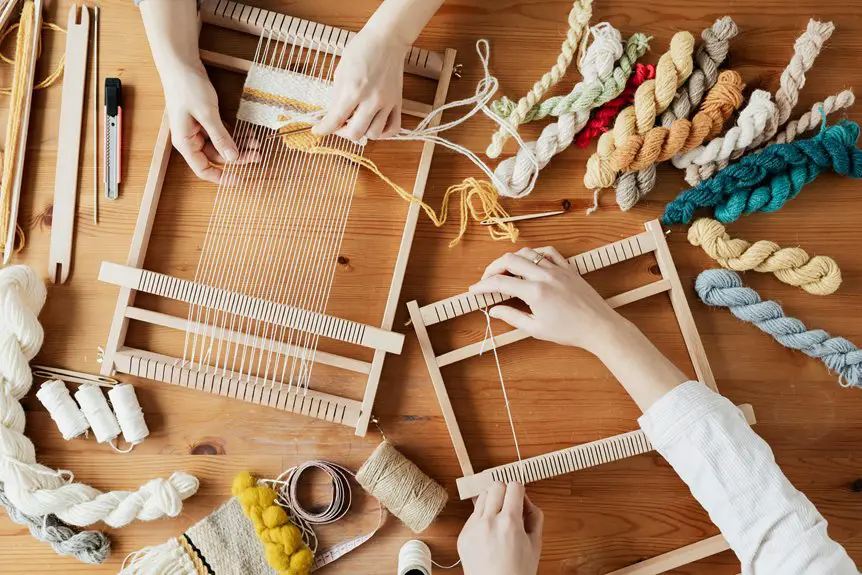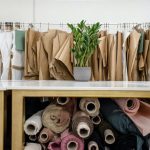You start by melting polypropylene pellets and extruding them into fine fibers through spinnerets. These fibers are stretched and laid down into a web using the spunbond process. Then, the web bonds through thermal methods, fusing fibers with heat and pressure, or chemical adhesives. To boost strength and smoothness, the fabric passes through heated rollers in calendering. With these steps, you get a strong, lightweight, and durable non-woven polypropylene fabric ready for many uses. Discover more about each stage’s role and benefits.
Table of Contents
Key Takeaways
- Polypropylene polymer is melted and extruded through spinnerets to form continuous filaments for fiber creation.
- The melt blowing or spunbond process stretches fibers with hot air to produce fine, strong microfibers.
- Fibers are laid into a web and bonded using thermal bonding or chemical adhesives to form a durable fabric.
- Calendering passes the fabric through heated rollers to compress fibers, enhancing strength, smoothness, and durability.
- Finished fabric undergoes quality control tests like tensile strength and visual inspection before distribution and use.
Overview of Polypropylene Material
Polypropylene is a versatile thermoplastic polymer that you’ll find in many everyday products. When you handle polypropylene, you’re working with a material known for its toughness, chemical resistance, and lightweight nature.
It’s made from the polymerization of propylene gas, turning into long chains that give it strength and flexibility. You’ll notice polypropylene’s ability to resist moisture and many chemicals, which makes it ideal for packaging, textiles, and even automotive parts.
Its semi-crystalline structure gives it a balance between rigidity and impact resistance. Plus, polypropylene’s melting point is relatively high, so it withstands heat better than many other plastics.
Understanding these properties helps you appreciate why polypropylene is the backbone for non woven fabrics used in medical supplies, hygiene products, and filtration materials.
Polymer Extrusion and Melt Blowing
You start by melting the polypropylene polymer using precise extrusion techniques to prepare it for fiber formation.
Then, the melt blowing process rapidly shapes these molten polymers into fine fibers that form a web.
Finally, various bonding methods hold the fibers together to create a strong, uniform fabric.
Polymer Melting Techniques
Molten polymer flows like liquid lava through specialized machinery, transforming solid pellets into usable fibers and films.
You begin by feeding polypropylene pellets into an extruder, where they’re heated until they melt into a viscous liquid. This molten polymer then passes through a die that shapes it into thin streams or sheets.
In melt blowing, you force this melted polymer through tiny nozzles while high-velocity hot air stretches the streams into fine microfibers. You carefully control temperature and pressure to guarantee uniform melting and smooth flow, which are essential for consistent fiber quality.
These melting techniques let you convert raw polypropylene into a workable form, setting the stage for the next steps in producing nonwoven fabrics with desired strength and texture.
Fiber Formation Process
Once the polymer is melted and shaped, it moves into the fiber formation stage where extrusion and melt blowing take center stage.
You’ll start by forcing the molten polypropylene through tiny spinnerets in the extrusion process, creating continuous filaments. These filaments rapidly cool and solidify as they exit.
Next, melt blowing uses high-velocity hot air to stretch these extruded fibers, making them finer and forming a nonwoven web. This process not only reduces fiber diameter but also increases fabric softness and filtration efficiency.
By controlling air pressure and temperature, you can adjust fiber thickness and web density, tailoring the fabric’s properties.
This fiber formation process is essential because it directly impacts the strength, texture, and functionality of the final nonwoven polypropylene fabric.
Web Bonding Methods
Although fiber formation creates the essential building blocks, web bonding methods like polymer extrusion and melt blowing hold the fibers together to form a durable nonwoven fabric.
With polymer extrusion, you melt polypropylene pellets and force the molten polymer through spinnerets, creating continuous filaments. These filaments lay down in a web, bonding as they cool.
Melt blowing works differently; it uses high-velocity hot air to stretch the molten polymer into fine microfibers. These microfibers deposit randomly onto a conveyor, forming a dense, uniform web.
Both methods guarantee the fibers interlock without weaving or knitting, giving the fabric strength and flexibility.
Spunbond Process Explained
Now, you’ll learn how the spunbond process uses fiber extrusion to create continuous filaments.
These filaments are then laid down to form a strong, uniform web.
Understanding this technique is key to grasping how non woven polypropylene fabric gets its structure.
Fiber Extrusion Method
The fiber extrusion method, commonly known as the spunbond process, transforms molten polypropylene into continuous filaments that form the fabric’s backbone.
You start by feeding polypropylene pellets into an extruder, where heat melts them into a viscous liquid. This molten polymer is then forced through tiny spinnerets, forming fine continuous filaments.
As these filaments exit, you quickly cool and solidify them using air jets. You then stretch the fibers to align their molecules, increasing strength and durability.
The filaments are laid down onto a moving belt, ready for bonding into fabric. This method lets you produce lightweight, strong fibers efficiently without needing additional fibers or binders, making it ideal for many nonwoven fabric applications.
Web Formation Technique
When you watch the spunbond process in action, you’ll see how continuous filaments are carefully laid down to form a web that acts as the fabric’s foundation.
This technique spins molten polypropylene into long fibers, which are then stretched and directly deposited onto a moving belt. The fibers bond together through heat and pressure, creating a strong, uniform sheet without weaving or knitting.
You’ll appreciate how this method offers:
- Consistent strength and durability, perfect for demanding uses
- Lightweight yet resilient fabric that feels comfortable
- Eco-friendly production with minimal waste
Carding and Web Formation
Although it might seem simple, carding and web formation play a crucial role in shaping the fibers into a uniform, continuous web that you’ll later use to create non woven polypropylene fabric.
First, carding machines disentangle and align the polypropylene fibers by passing them through a series of rotating drums covered with fine wire teeth. This process separates clumps and orients the fibers in a parallel fashion, improving the fabric’s strength and consistency.
After carding, these aligned fibers are laid down to form a thin, even web. This web is delicate but fundamental, as it provides the base structure for the fabric.
Thermal Bonding Techniques
You’ll find that thermal bonding techniques play an essential role in transforming the delicate fiber web into a strong, cohesive non woven polypropylene fabric.
By applying controlled heat and pressure, the fibers partially melt and fuse together, creating a durable yet flexible material without the need for adhesives. This method guarantees the fabric maintains its lightweight and breathable qualities.
When you experience thermal bonding, you benefit from:
- Enhanced strength and durability that withstands daily wear
- A smooth, uniform texture that feels comfortable against the skin
- Eco-friendly processing by avoiding chemical additives
Thermal bonding lets you enjoy non woven polypropylene fabric that’s both reliable and gentle, perfect for a variety of applications from medical masks to reusable bags.
Chemical Bonding Methods
Alongside thermal bonding, chemical bonding methods offer another way to hold non woven polypropylene fibers together. You apply adhesives or binders that create strong chemical links between fibers, enhancing fabric integrity without heat. This process suits delicate fibers sensitive to high temperatures and allows precise control over bonding areas.
Here’s a quick comparison of common chemical bonding methods:
| Method | Binder Type | Application |
|---|---|---|
| Latex Coating | Synthetic latex | Sprayed or dipped onto fabric |
| Resin Bonding | Polymeric resins | Applied with rollers or brushes |
| Emulsion | Water-based emulsions | Evenly spread or sprayed |
Calendering for Fabric Strength
When you want to boost the strength and smoothness of non woven polypropylene fabric, calendering plays a key role. This process involves passing the fabric through heated rollers that compress and bond the fibers more tightly.
You’ll notice the fabric becomes denser, gaining enhanced durability and a polished finish. Calendering guarantees the material feels stronger and looks more uniform, which is essential for many applications.
Here’s what calendering brings to your fabric:
- Increased tensile strength for lasting performance
- A smooth, attractive surface that’s pleasant to touch
- Improved resistance to wear and tear, extending fabric life
Quality Control and Testing
After calendering enhances the strength and finish of non woven polypropylene fabric, it’s important to verify that these improvements meet the required standards. You’ll conduct quality control tests to assess durability, weight, and uniformity. These tests ascertain the fabric performs well in its intended applications and maintains consistent quality.
Here’s a quick overview of common tests:
| Test Type | Purpose |
|---|---|
| Tensile Strength | Measures fabric’s resistance to force |
| Basis Weight | Confirms fabric weight per unit area |
| Visual Inspection | Detects surface defects or irregularities |
Applications of Non Woven Polypropylene Fabric
Non woven polypropylene fabric offers versatile solutions across many industries due to its durability, lightweight nature, and cost-effectiveness.
When you use this fabric, you tap into its adaptability for everyday needs and specialized functions alike. Whether you’re looking for reliable protection or eco-friendly packaging, it fits the bill.
You’ll find it in:
- Medical supplies like masks and gowns, providing essential safety without sacrificing comfort.
- Agriculture, where it shields plants from pests and weather, helping your garden thrive.
- Retail and packaging, offering strong, reusable bags that reduce waste and look good.
Frequently Asked Questions
What Are the Environmental Impacts of Non Woven Polypropylene Fabric Production?
You should know producing non woven polypropylene fabric uses fossil fuels and generates plastic waste, contributing to pollution. However, it’s lightweight and recyclable, so minimizing environmental impact depends on responsible manufacturing and proper disposal practices.
How Is Non Woven Polypropylene Fabric Disposed of or Recycled?
You can recycle non woven polypropylene fabric through specialized facilities, but many times it ends up in landfills or incinerators. Proper disposal or recycling helps reduce environmental impact and supports sustainable waste management practices.
What Safety Precautions Are Needed During Manufacturing?
Like walking through a maze of spinning gears, you need sturdy gloves, eye protection, and proper ventilation to stay safe. Don’t forget fire-resistant clothing and training, as polypropylene fibers can ignite easily during production.
Can Non Woven Polypropylene Fabric Be Dyed or Printed?
You can dye or print non woven polypropylene fabric, but it’s tricky since it resists traditional dyes. You’ll need special pigments or printing methods like heat transfer or screen printing for vibrant, lasting colors on this material.
How Does Humidity Affect the Production Process?
You’ll find that high humidity can cause fibers to clump and affect bonding, leading to weaker fabric. Controlling moisture levels guarantees consistent quality and strength during production, so you shouldn’t overlook humidity’s impact on your process.
- Tetron Fabric for Marine Applications: Durability and Use Cases - June 18, 2025
- Tetron Fabric for Outdoor Furniture: Weather Resistance and Care - June 18, 2025
- Tetron Fabric for Wall Coverings: Style and Application Tips - June 18, 2025







